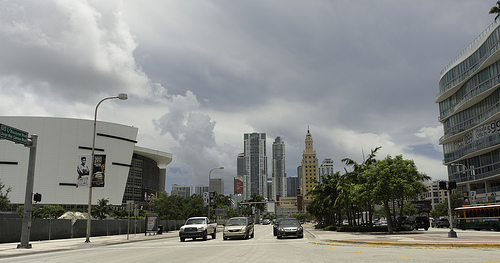On the impact of complete streets
Following a recent report hailing the benefits of “complete streets,” two projects that embrace the concept are garnering attention — and even applause. Miami, Florida’s Department of Transportation just approved the city’s plan to revamp Biscayne Boulevard, expanding pedestrian and biking areas and limiting vehicle lanes, while Normal, Illinois’ project, which reworked its neighborhood with $47 million back in 2010, is being hailed as a prime example of complete streets’ success by the American Society of Landscape Architects (ASLA).

Image from Jimmy Baikovicius.
What is a complete street, exactly? It’s designed for everyone who uses it, not just cars. As a concept, it calls for “safe, comfortable, and convenient access to community destinations and public places — whether walking, driving, bicycling, or taking public transportation,” according to the National Complete Streets Coalition. The Coalition, which was founded in 2004, aims to consider people and places when creating and maintaining streets, and recently published a report, Safer Streets, Stronger Economies, on complete streets projects.
Analyzing 37 projects across 31 cities in 18 states, that report found that streets were usually safer post-complete streets implementation. It also determined that the projects often encouraged people to travel by foot, bike and transit, and that the projects were “remarkably affordable,” with some small improvements requiring just a few thousand dollars (though bigger projects have numbered in the millions).
Some of the recommended improvements are exemplified by the Normal, Illinois project (check out the video to see the town’s changes in action). Normal widened and repaired its sidewalks, created a new traffic circle, and reconstructed a major boulevard. It also built Uptown Station, offering different forms of transportation. After the project, more than 40% of all trips in the area were made on foot or by bike. Normal also saw a 16% rise in property values, plus new private investment totaling $160 million — which, of course, may or may not have been related to the improvements.
The report lists a number of benefits which, the Coalition says, are linked to complete streets renovations. They found that car collisions dropped in 70% of the projects, and that injuries dropped in 56% of the projects; this translates, according to the Coalition, to $18.1 million in averted total collision costs each year. While the costs of carrying out such projects were relatively low — the average cost was $2.1 million, which, notes ASLA, is “far less than the $9 million average cost of projects in state transportation improvement plans” — they seemed to contribute to economic development, with increases in investment, higher employment, higher property values and new business reported in the areas, though it’s difficult to draw a direct line between the projects and these outcomes.
Miami’s Downtown Development Authority (DDA) plans to create a complete street out of highly-trafficked Biscayne Boulevard by cutting vehicle lanes from eight to four or six. It would also drop the number of parking spaces, from 388 to 187, to make room for medians with greenery and walkways, and would replace a shared bike lane with a bike-only lane. The estimated price tag for the project is $24 million. The DDA will work with the Miami Parking Authority, and will also have to work with the county to reconfigure intersections and develop a comprehensive plan for how the changes will be phased in.
More than 700 areas have agreed to adopt similar initiatives. Just this week, the mayor of Pittsburgh, Pennsylvania issued an executive order on implementing the policy, about a month after he’d announced a $32 million investment in traffic signals, sidewalks, bike lanes and other upgrades to encourage walking, biking and public transit in the city. The mayor of Des Moines, Iowa, also recently advocated for complete streets, and is working with a planning organization to develop a template for other metro areas to use; Des Moines adopted its complete-streets policy back in 2008.
Related Posts
Category: Transportation

















